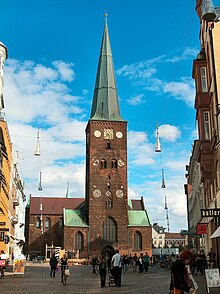
Aarhus C is a postal district in the city of Aarhus, Denmark, consisting of the Inner city, Vesterbro, University of Aarhus, Frederiksbjerg, Langenæs and Aarhus Ø, with postal code 8000. The district is commonly defined as the area enclosed by the ring road of Ring 1, and in the west by the Aarhus Harbour and shoreline.

Den Gamle By is an open-air town museum located in the Aarhus Botanical Gardens, in central Aarhus, Denmark. In 1914, the museum opened as the Denmark's first open-air museum of its kind, concentrating on town culture rather than village culture, and to this day it remains one of just a few top rated Danish museums outside Copenhagen, serving more than 400,000 visitors pr. year. Today the museum consists of 75 historical buildings collected from 20 townships in all parts of the country. The town itself is the main attraction but most buildings are open for visitors; rooms are either decorated in the original historical style or organized into larger exhibits of which there are 5 regular with varying themes.

Midtbyen, also known as Aarhus Center or City, is the inner part of Aarhus. Midtbyen is part of district Aarhus C, mainly with postal code 8000, together with Vesterbro, Nørre Stenbro Trøjborg and Frederiksbjerg and has a population of around 90000.

Vesterbro is a neighbourhood of Aarhus, Denmark. It is located in the Aarhus C district, west of the city centre of Indre By. Vesterbro used to be farmland outside the city walls, and the neighbourhood's development progressed, when the city walls of Aarhus were demolished in 1851.

Domkirkepladsen 1 is a listed building and the former Bank of Denmark branch building in Aarhus, Denmark. The bank was built in 1926 and was listed in the Danish national registry of protected buildings and places by the Danish Heritage Agency on 22 February 1996. The bank is situated on the Store Torv square in the central Indre by neighbourhood next to the cathedral where it has functioned as a bank since its completion until today. The building is no longer in use by the Bank of Denmark but still functions as a bank, occupied by a branch of Nykredit.

Trods Katholm is a former manor house and a listed building in Aarhus Municipality, Denmark. The house was built in 1606 and was listed by the Danish Heritage Agency on 2 September 1994. The building complex is situated in the central Indre By neighbourhood on Fredens Torv by the Aarhus River. It is one of the oldest preserved buildings in the city with a history of many different uses. The listing includes the main building of the former manor built in 1606 and an adjacent former warehouse building from 1850.

Badstuegade 1H is a house and a listed building in Aarhus, Denmark. The house was built in 1809 and was listed on the Danish registry of protected buildings and places by the Danish Heritage Agency on 7 October 1970. The house is situated in the historic and central Latin Quarter neighbourhood on Badstuegade by Pustervig square.

Thorup's Kælder is a listed structure and a bar in Aarhus, Denmark. It is a basement built in approximately 1300 by Cistercian monks. The basement was listed on the Danish registry of protected buildings and places by the Danish Heritage Agency on 1 January 1959. The listing is officially "Den Grå Kannikegård" which refers to the entirety of the building at the address although only the basement beneath it is protected. The structure is situated in the historic Latin Quarter neighbourhood on Store Torv adjacent to the Cathedral.

Mejlgade is a street in Aarhus which runs north to south from Østbanetorvet to Skolegade and intersects Nørrebrogade. The street is situated in the historic Latin Quarter neighborhood and has the highest number of historic and listed buildings in the city. Mejlgade is one-way and no-parking zone for cars for most of its length and pedestrians and cyclists are given priority. The single lane is tiled and a part of the Cykelringen bicycle ring which circumnavigates the city center. Mejlgade has a high number of small specialty shops and some cafés and bars.
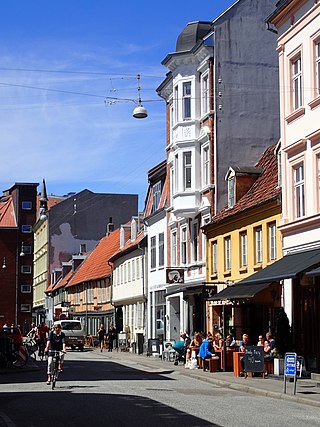
Vestergade is a street in Aarhus, Denmark, which runs east to west from the central square of Store Torv to the city park of Åparken at Carl Blochs Gade, intersecting the main streets of Grønnegade and Vester Allé along its course. Vestergade begins in the Indre By neighborhood and ends in neighborhood of Vesterbro, close to CeresByen. Vestergade has some of the best preserved 18th-century merchant estates in Aarhus and a history of creativity and artistic expression.

Klostergade is a street in Aarhus which runs east from Grønnegade to Studsgade, intersecting a number of streets.

Skolegade is a street in Aarhus, Denmark which runs north to south from Mejlgade to Mindebrogade. The street is situated in the Midtbyen neighborhood. Skolegade is home to two listed buildings and runs past the Aarhus Theater. Skolegade is an area with many bars and eateries, and it has a lively nightlife. The street is from at least medieval times with many historic buildings.

Hotel Royal is a historic hotel in the heart of Aarhus, Denmark, in the central Indre By neighborhood. It overlooks Aarhus Cathedral and the large Store Torv square. The hotel is among the highest ranked hotels in Denmark with a history as the most prestigious in the city.

The architecture of Aarhus comprises numerous architectural styles and works from the Middle Ages to present-day. Aarhus has a well-preserved medieval city center with the oldest dwellings dating back to the mid-1500s and some ecclesiastical structures such as St. Clemen's Cathedral and numerous smaller churches that can be traced back to the 1100s. The industrialization of the 19th and 20th centuries left distinctive industrial structures, important National romantic works and some of the best examples of Functionalist architecture in the country. The history of the city as a Viking fort is evidenced in the street layout of the Latin Quarter, the wider Indre By neighborhood testifies to its later role as a Market town and center of commerce while the Frederiksbjerg, Trøjborg and Marselisborg districts showcase the first cohesive urban planning efforts of the early 20th century.
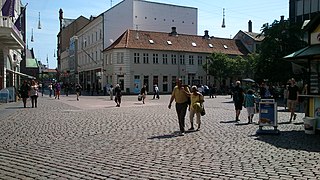
Lille Torv is a cobbled public square located in the Indre By neighborhood in Aarhus, Denmark. It is situated between the squares of Store Torv and Immervad in the historic Latin Quarter neighborhood and it is one of the oldest public squares in Aarhus. The streets of Vestergade, Guldsmedgade, Immervad and Badstuegade radiates from Lille Torv. It is today a venue for public events and gatherings in the city. The square is home to some notable buildings such as the storied Meulengracht's House and the listed Business- and Agricultural Bank of Jutland.

Bispetorv is a public square located in the Indre By neighborhood in Aarhus, Denmark.
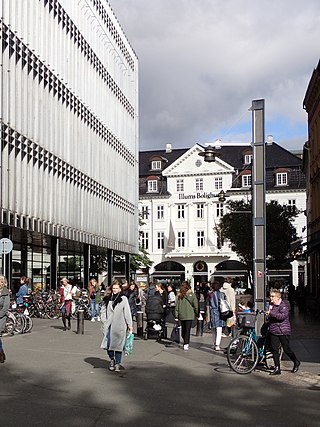
Immervad, previously Emmervad, is a pedestrian street in Aarhus, Denmark, which runs north to south from Lille Torv to Åboulevarden and Frederiksgade. The alley Sankt Clemens Stræde leads to Immervad from the east. The street is situated in the historic Latin Quarter neighborhood and has existed as a road or street since the Viking Age when it was used as the eastern ford to cross the Aarhus River. Immervad is fairly short at just 110 meters long but it is one of the streets with the most foot traffic in Aarhus. At the southern section of the street is the bridge of Frederiksbroen, the first bridge built to cross the river in the city.

Ryesgade is a 240-meter-long street in Aarhus, Denmark. It is located in the central Town Center neighborhood and runs south to north from Banegårdspladsen to Søndergade and provides access to Rosenkrantzgade. Ryesgade is today one the busiest commercial pedestrianized streets in Denmark. It was created in 1873 as an extension to Søndergade to connect the Central Station to the rest of the inner city. Ryesgade is one of several streets in Denmark named for the Danish general Olaf Rye who became famous for his exploits during the First Schleswig War.
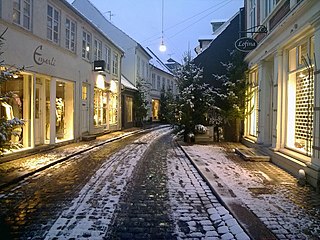
Volden is a 180 meters long street in Aarhus, Denmark, situated in the historic Latin Quarter neighborhood. Volden runs from south to north from Store Torv to Graven and intersects Rosensgade roughly in the middle. Volden was created some time before year 1500 on and in the westernmost rampart used to defend the early Viking settlement. It is one of the oldest streets in the city and used to mark the western city limits. Volden is fairly narrow and is a pedestrianized street with cars forbidden access.

Vesterbro Torv is a public square located in the Vesterbro neighborhood of Aarhus, Denmark. Vesterbro Torv is the junction where 8 street meet; Vesterbrogade, Hjortensgade, Langelandsgade, Teglværksgade, Nørre Allé, Vesterport, Vester Allé and Janus la Cours Gade. It is one of the most heavily trafficked areas in the city, receiving traffic from Åbyhøj and Brabrand in the west along Silkeborgvej and from Tilst in the north-west along Viborgvej. The square is designed as a central "island" surrounded by streets. The central part is primarily used for parking although there is a few recreational facilities such as public toilets and benches.
